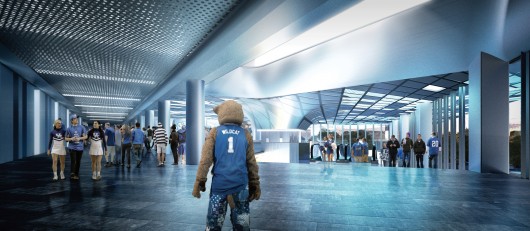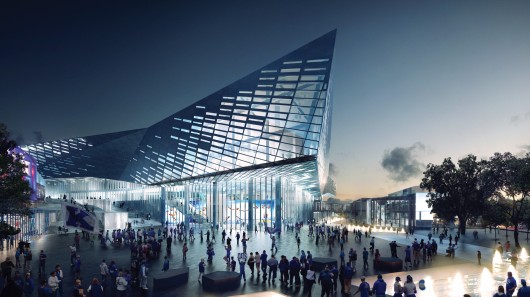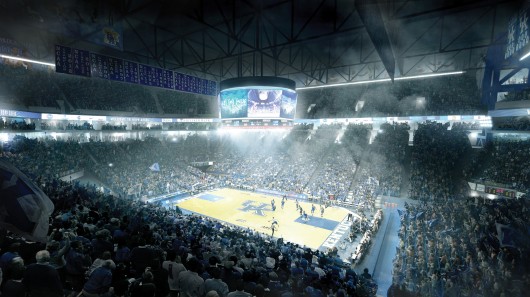NBBJ and EOP Architects have revealed a $310 million plan to renovate Rupp Arena, home of the University Kentucky Wildcats.
The 38-year old arena will have its façade re-clad in glass up to 40 feet high. A new concourse will wrap around the stadium and provide expansive views both of Lexington, Ky., and the court, so patrons will be able to move around the building without missing any action.
“Most importantly, the new Rupp will preserve the authenticity of the current building and respect the traditions of University of Kentucky basketball from over the decades,” NBBJ said in a press release. “Even though the bowl will be drastically upgraded with a new suite level, the two-tier system appearance from the original bowl will be preserved. The redesign will also keep the same number of seats as the original facility and the structural towers that defined the old Rupp will be rehabilitated as a wayfinding element.”
The stadium renovation is not just about the stadium, it's about creating a unique and upgraded space in the city, ArchDaily reports.
On the building's east side, a plaza will allow for large crowds; to the north and west of Rupp, a gorge will connect downtown to a newly planned park. The south will be "an urban edge that fosters the future development of downtown.”
To see a summary of the design, you can watch this video:
Related Stories
| Aug 8, 2022
Mass timber and net zero design for higher education and lab buildings
When sourced from sustainably managed forests, the use of wood as a replacement for concrete and steel on larger scale construction projects has myriad economic and environmental benefits that have been thoroughly outlined in everything from academic journals to the pages of Newsweek.
AEC Tech | Aug 8, 2022
The technology balancing act
As our world reopens from COVID isolation, we are entering back into undefined territory – a form of hybrid existence.
Legislation | Aug 5, 2022
D.C. City Council moves to require net-zero construction by 2026
The Washington, D.C. City Council unanimously passed legislation that would require all new buildings and substantial renovations in D.C. to be net-zero construction by 2026.
Cultural Facilities | Aug 5, 2022
A time and a place: Telling American stories through architecture
As the United States enters the year 2026, it will commence celebrating a cycle of Sestercentennials, or 250th anniversaries, of historic and cultural events across the land.
Sponsored | | Aug 4, 2022
Brighter vistas: Next-gen tools drive sustainability toward net zero line
New technologies, innovations, and tools are opening doors for building teams interested in better and more socially responsible design.
| Aug 4, 2022
Newer materials for green, resilient building complicate insurance underwriting
Insurers can’t look to years of testing on emerging technology to assess risk.
Sustainability | Aug 4, 2022
To reduce disease and fight climate change, design buildings that breathe
Healthy air quality in buildings improves cognitive function and combats the spread of disease, but its implications for carbon reduction are perhaps the most important benefit.
Multifamily Housing | Aug 4, 2022
Faculty housing: A powerful recruitment tool for universities
Recruitment is a growing issue for employers located in areas with a diminishing inventory of affordable housing.
Multifamily Housing | Aug 3, 2022
7 tips for designing fitness studios in multifamily housing developments
Cortland’s Karl Smith, aka “Dr Fitness,” offers advice on how to design and operate new and renovated gyms in apartment communities.
Building Materials | Aug 3, 2022
Shawmut CEO Les Hiscoe on coping with a shaky supply chain in construction
BD+C's John Caulfield interviews Les Hiscoe, CEO of Shawmut Design and Construction, about how his firm keeps projects on schedule and budget in the face of shortages, delays, and price volatility.





















